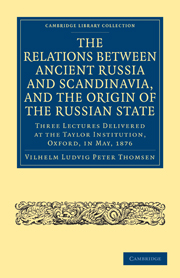 The Relations between Ancient Russia and Scandinavia, and the Origin of the Russian State
The Relations between Ancient Russia and Scandinavia, and the Origin of the Russian State Book contents
- Frontmatter
- PREFACE
- Contents
- LECTURE I ON THE INHABITANTS OF ANCIENT RUSSIA, AND THE FOUNDATION OF THE RUSSIAN STATE
- LECTURE II ON THE SCANDINAVIAN ORIGIN OF THE ANCIENT RUSS
- LECTURE III ON THE DENOMINATION AND HISTORY OF THE SCANDINAVIAN ELEMENT IN RUSSIA
- APPENDIX: OLD RUSSIAN PROPER NAMES
- ADDITIONS
- INDEX
LECTURE I - ON THE INHABITANTS OF ANCIENT RUSSIA, AND THE FOUNDATION OF THE RUSSIAN STATE
Published online by Cambridge University Press: 29 August 2010
- Frontmatter
- PREFACE
- Contents
- LECTURE I ON THE INHABITANTS OF ANCIENT RUSSIA, AND THE FOUNDATION OF THE RUSSIAN STATE
- LECTURE II ON THE SCANDINAVIAN ORIGIN OF THE ANCIENT RUSS
- LECTURE III ON THE DENOMINATION AND HISTORY OF THE SCANDINAVIAN ELEMENT IN RUSSIA
- APPENDIX: OLD RUSSIAN PROPER NAMES
- ADDITIONS
- INDEX
Summary
From the first dawn of authentic history that vast territory which now constitutes European Russia, or at least the large central portion of it, appears to have been inhabited, in the main, by the same nationalities which still form the bulk of its population, that is, partly by Slavonians, partly by Finnish and Tataric tribes. But the relations between these various nationalities were then quite different from what they are at the present day; the overwhelming superiority, numerically and politically speaking, which the Slavonic element has acquired over the others, has been the work of comparatively modern times, while the foundation of a Russian state belongs to none of them.
We must for a moment glance at the primitive history of the Slavonians in Russia and the ethnography of that extensive country at the period when we first meet with the name of Russia.
The Slavs or Slavonians are a branch of that great family which we call the Aryan or the Indo-European family, which, from time out of mind, has occupied by far the greater part of Europe. Of course the Slavonians have lived in our part of the world quite as long as any of their brother-peoples; but, except their very nearest kinsmen and neighbours, the Lithuanians and the Lets, there are none of the Aryan tribes upon which history begins to cast its light so late as upon the Slavonians.
- Type
- Chapter
- Information
- The Relations between Ancient Russia and Scandinavia, and the Origin of the Russian StateThree Lectures Delivered at the Taylor Institution. Oxford, in May, 1876, pp. 1 - 36Publisher: Cambridge University PressPrint publication year: 2010First published in: 1877


